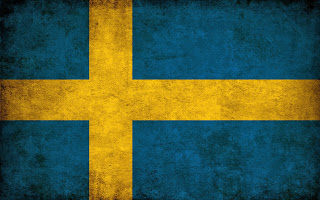The flag of Sweden is a Scandinavian cross that extends to the edges of the flag. This Scandinavian cross represents Christianity. The design and colours of the Swedish flag are believed to have been inspired by the present Coat of arms of Sweden of 1442, which is blue divided quarterly by a cross pattée of gold, and modelled on the Danish flag. Blue and yellow have been used as Swedish colours at least since King Magnus III's royal coat of arms of 1275.
The dimensions of the Swedish flag are 5:2:9 horizontally and 4:2:4
vertically. The dimensions of the Swedish flag with a triple-tail are
5:2:5:8 horizontally and 4:2:4 vertically. The colours of the flag are
officially established through the Natural Color System to be NCS 0580-Y10R for the shade of yellow, and NCS 4055-R95B for the shade of blue.
The square-cut Swedish state flag is identical to the civil ensign. The
Swedish law does not regulate the design of the Swedish pennant, but it's recommended that its colour scheme should correspond with that of the flag.
The triple-tailed flag (tretungad flagga) is used as a military ensign (örlogsflaggan). Its overall ratio, including the tails, is 1:2. The flag is also used as the Swedish naval jack (örlogsgösen).
The jacks are smaller than the ensigns, but they have the same
proportions. The Swedish swallow-tailed flag was originally the King's
personal emblem, or the emblem representing a command conferred by the
King. It was at first two-pointed, but by the mid-17th century, the
distinctive swallow-tail-and-tongue appeared. The flag is also flown by
the defence ministry, while civil ministries fly square flags.
The Swedish royal flag (Kungl. flaggan) is still identical to the
triple-tailed military flag, but usually includes in its centre a white
field with the greater or the lesser coat of arms with the Order of the Seraphim, which has the King of Sweden as its Grand Master. The King personally decides about the specific use of the royal flag.
According to the mythology, the 12th-century King Eric IX saw a golden cross in the sky as he landed in Finland during the First Swedish Crusade
in 1157. Seeing this as a sign from God he adopted the golden cross
against a blue background as his banner, though the golden cross was
changed later to a yellow cross due to practicality. The problem with
the mythology is partly the fact that there are no contemporary sources
about the crusade and partly because there are no pictures or
descriptions of the flag until the middle of the 16th century.
It has also been suggested that the Swedish flag might have been a resistance flag against the Danish flag,
which is red with a white cross and has a mythological origin in 1219,
but are not depicted until late 14th century. According to this theory,
the Swedish flag was created during the reign of King Charles VIII, who also introduced the coat of arms of Sweden in 1442. The national coat of arms is a combination of King Albert's coat of arms of 1364 and King Magnus III's coat of arms of 1275, and is blue divided quarterly by a golden cross pattée.
Other historians claim that the Swedish flag was blue with a white
cross before 1420, and became blue with a golden cross only during the
early reign King Gustav I, who deposed King Christian II in 1521.
When used from a standalone flagpole, the size of the flag is
recommended to have a width equaling a fourth of the height of the pole.
When used from a flagpole extending from a building, the flag is
recommended to have a width equaling a third of the height (length) of
the pole. It is further recommended to fly the flag during daytime, and
to lower it no later than 9 pm. Only when the country is at war is it
recommended to fly the flag also at night.
Source: Wikipedia
This work released through CC 3.0 BY-SA - Creative Commons

No comments:
Post a Comment
Note: Only a member of this blog may post a comment.